The convoy from the star hotel was dispensed with early in the morning as French ambassador Emmanuel Lenain set out on a walking tour of the melting pot that was 19th and early 20th century central Calcutta.Keeping him company along the labyrinth of lanes, other than t2 and his security detail, were his Leica camera and Iftekhar Ahsan, the founder of Calcutta Walks.
“This is the area ensconced between the White Town of the British rulers and the Black Town of the natives. In this ‘grey town’, comprising Bowbazar and Burrabazar, there were tradespeople from various communities and cultures settling who served both groups of residents to their north and south,” said Iftekhar, referring to the jewellery and carpentry, dentistry and umbrella-making, watch repairing and opticians’ quarters in the vicinity.
Our first stop was Bauddha Dharmankur Sabha on Buddhist Temple Street. The organisation was founded in Calcutta in 1892 to revive Buddhism in India. The building opened in 1903. They used to bring out a monthly magazine on Buddhism in Bengali, Jagajjyoti, since 1908. “The wheel at the centre of India’s national flag was added from a pillar from the Buddhist emperor Asoka’s time. A religion that was born and thrived in this land has less than one per cent followers today,” Iftekhar said.Walking towards Bow Barracks, the ambassador paused to watch the activities at a scrap dealer’s, with two men busy sorting newspapers. It was explained to him how they are recycled as paper bags. “Calcutta has the most sustainable practices,” Iftekhar commented.
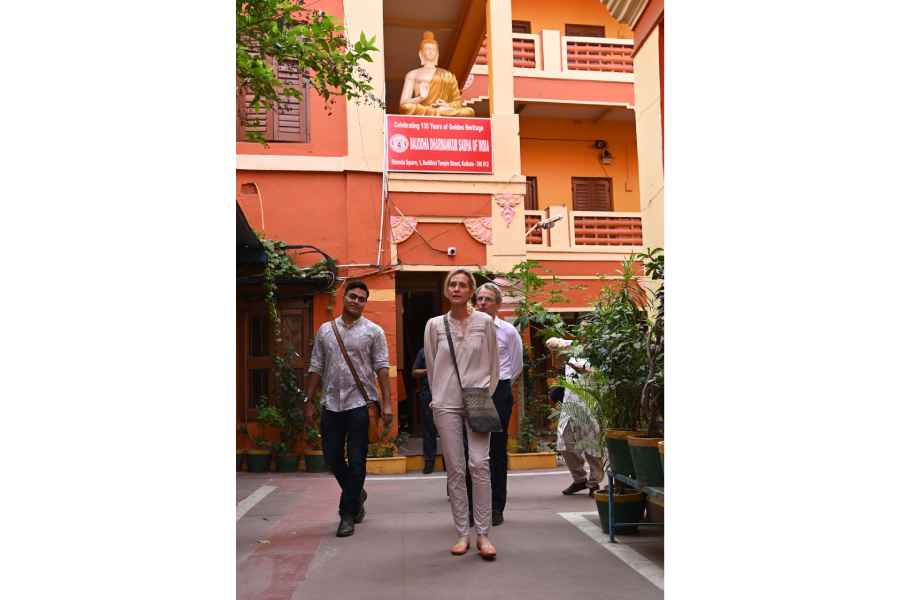
At the Bauddha Dharmankur Sabha
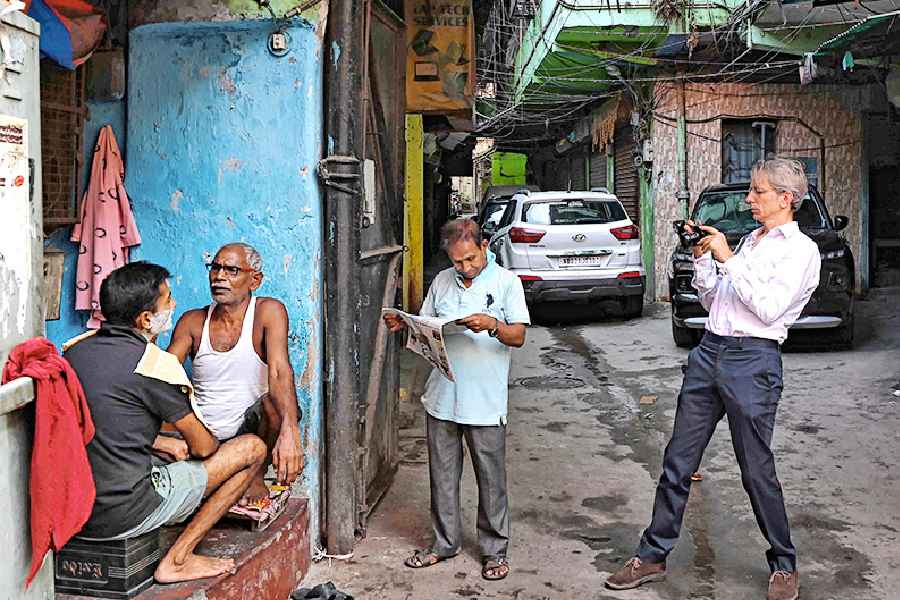
Emmanuel Lenain clicks a barber at work
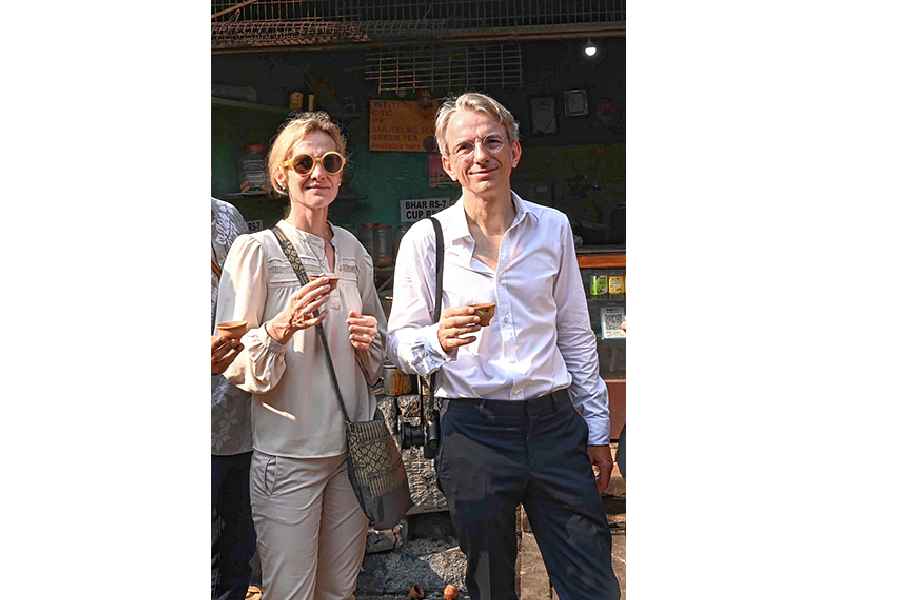
Emmanuel and Geraldine Lenain take a tea break
Bow Barracks, with its blocks of three-storeyed red buildings as if framing a rectangular slice of sky dotted with rows of crows and pigeons seated on overhead cables, was the next stop. “This housed soldiers during World War I. Now it has a sizeable Anglo-Indian population which is well-known for its Christmas celebration.”A grotto with pictures of Jesus Christ and one of Saint Teresa drew the ambassador’s attention. Next to him paused residents about to start the day murmuring a prayer before leaving.
Geraldine, the ambassor’s wife, was struck by the sight of Ambassador cabs on the road. “How have they survived here for so long? We don’t see them in Delhi,” she wondered. “Things take longer to leave Calcutta,” Iftekhar smiled.
Walking down Weston Street, Lenain stopped on spotting a barber shaving a customer with a razor blade in an alcove of a streetside building. Next to him, a man was reading a Hindi newspaper.
The source of the paper was sitting down the road, opposite a tea stall. As the group sipped tea in clay cups, Iftekhar pointed and said: “See, he is selling newspapers in English, Bengali, Hindi, Urdu and Odiya. In few other places, will you find such diversity.”
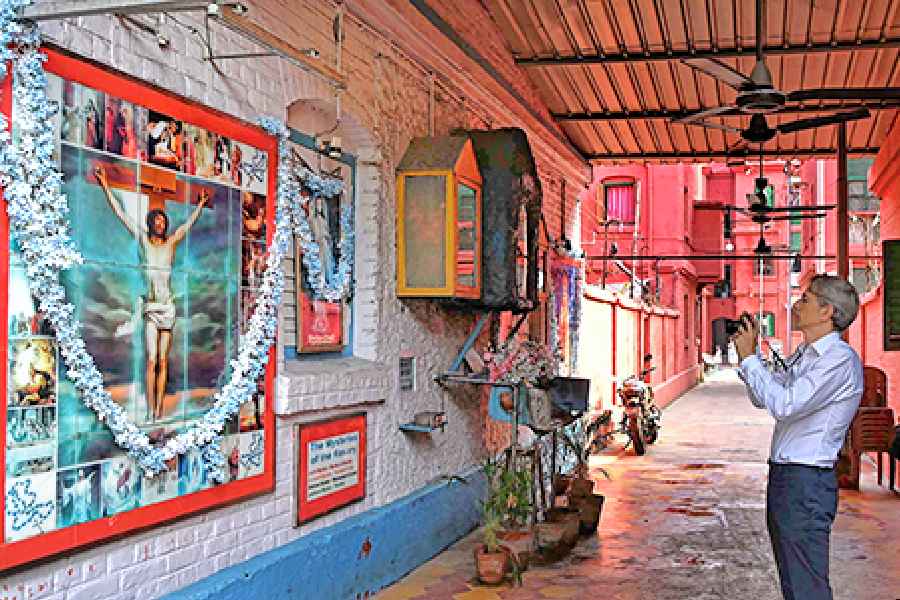
The grotto at Bow Barracks
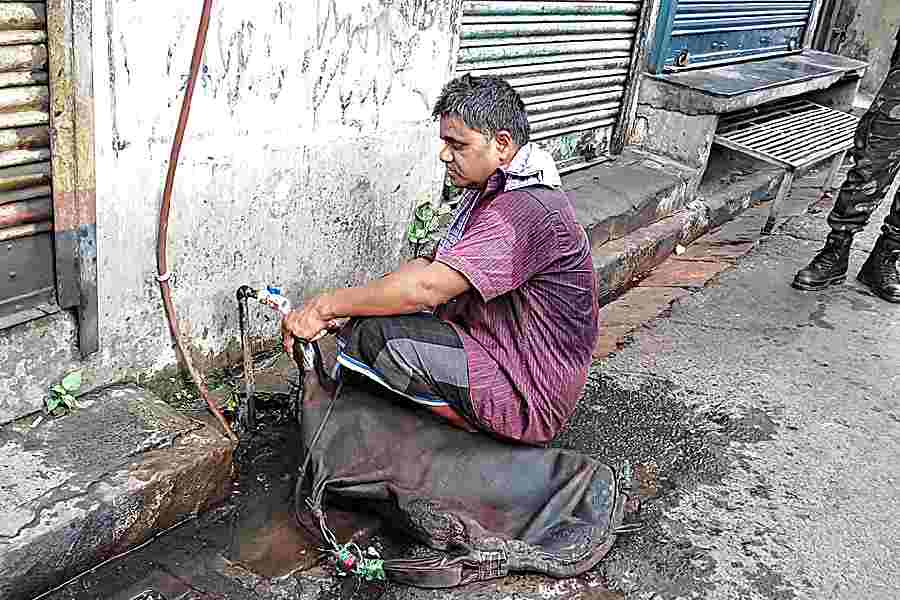
A bhistiwala refills his leather pouch
A bhistiwallah was walking by on Metcalfe Street. Like generations before him, he still supplies water in the leather pouch (bhisti) on his back — a living example of how time has stood still in some pockets. “Water costs Rs 20 per bhisti. My source is the roadside tap,” the man said in Hindi.
Iftekhar led the group to a metal structure protruding from the road surface at a corner of the junction of two lanes. “This is a cannon which must have been abandoned after a battle. Now it has become part of the street furniture. People use it to tie horses to, as a boundary for the lane...” “To sit on,” added Geraldine.
Opposite to it was an imambara, a mosque sacred to the Shia sect of Muslims. Down the street, some names on the letter boxes on a door made the ambassador stop for pictures. “So you have a Chinese community here?” he asked. “A pretty strong one but their numbers are depleting. There used to be a hundred thousand of them but now they are less than five thousand. Even this building will go. It is being developed,” came the response.
“The Chinese were invited by the British to set up a sugar mill here,” said Iftekhar. “Indians used different kinds of sweeteners across the country so the British found it inconvenient to monetise. The Chinese set up a refined sugar mill just outside the city (in Achipur, Budge Budge) and the product came to be locally called chini, meaning Chinese. With the Chinese settlers came other trades like hand-pulled rickshaw, Chinese food, furniture-making, shoe-making, leather tanning, dentistry etc. Of them, the Hakka sect does food and leather, the Cantonese does furniture and the Hupeh is into dentistry and herbal medicine.”
The next stop was the Parsi fire temple, consecrated in 1912. The fire here had been brought from Navsari, Gujarat, and is reportedly kept in a giant urn installed on the first floor, which is out of bounds for non-Zoroastrians. “I had been inside such a temple,” the ambassador said, though he could not recall in which city. “You are very lucky!” was the reaction from the rest of the group. A stained glass painting, by city artist Katayun Saklat, of the sun on a wall indicated the direction of the rising sun. “They face that way and do their ablutions,” said Iftekhar.Across the road was a mosque named after Prince Aga Khan, the 48th spiritual head (Imam) of Shia Ismaili Muslims. “It is called a Jamat Khana, which means a gathering hall, not a prayer hall. But they do pray here. Nobody is allowed in other than followers,” Iftekhar said.
As photographs were being taken from outside the locked gate, Geraldine asked about the building’s architecture. “All architecture in Calcutta, be it a mosque or a temple, has European elements,” he replied.

A stained glass painting at the Parsi fire temple. The sun on a wall indicates the direction of the rising sun for the devotees to face and do their ablutions
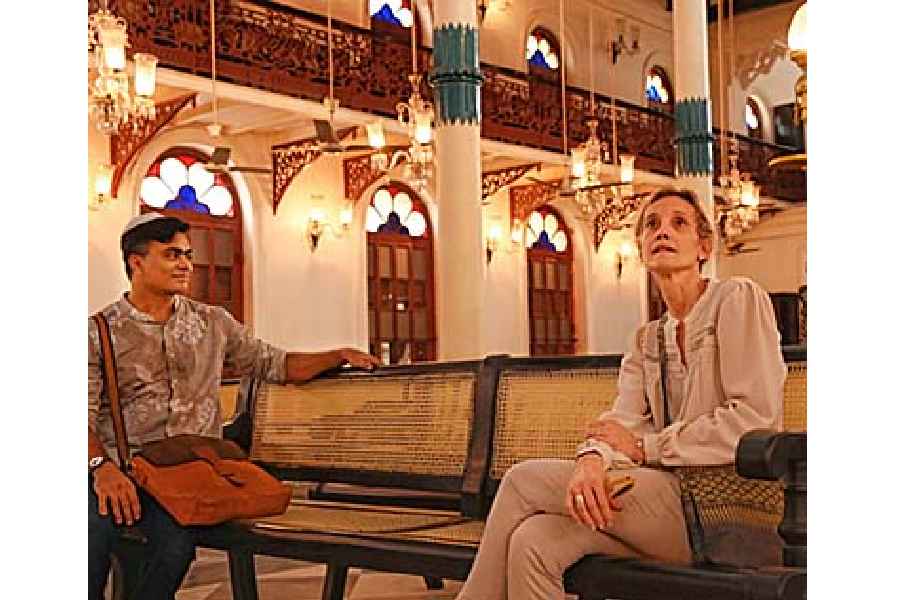
Geraldine Lenain with Iftekhar Ahsan at Beth El Synagogue
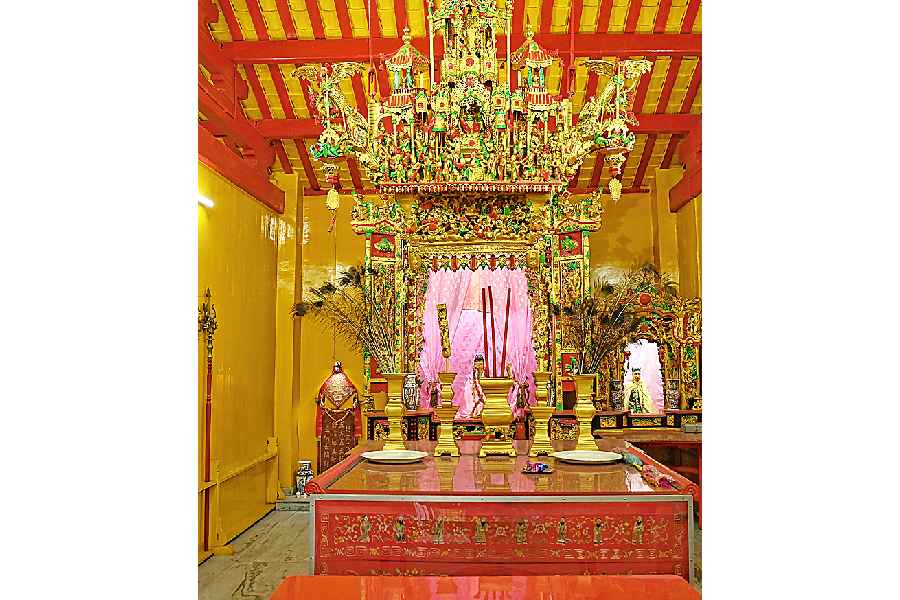
Inside Sea Ip Church
Walking across the tramline on BB Ganguly Street, Iftekhar drew attention to the mode of environment-friendly transport that is part of the city’s history but fast disappearing from its streets. “The tram company was formed in 1880 and trams in those days were pulled by horses. They were meant for goods transportation,” he said, adding that public use of all transport in India is “incidental”. “It was all originally intended for goods transport.”
We were now approaching the old Chinatown in Tirettabazar. It was well past 8am and the early morning Chinese breakfast snacks market was over on Chhatawala Gali but some fritters and momos were still on sale.At the Sea Ip Church, we met a couple of members of the Indian Chinese community. Lenain started conversing with one in Mandarin. “He said he has served in China. I told him I am just back from Beijing. My parents had settled in Calcutta 80 years ago from China,” the man who introduced himself as Lawrence later told t2. The ground floor houses a library but the city’s only Chinese newspaper that used to be read by community members seated at the long table, was missing. “Printing was stopped during the pandemic,” he shrugged.
The shrine upstairs, dedicated to Kwan Yin, the goddess of war, mercy and love, was open. Originally a male god, she is said to have transformed, modelled on one of the Boddhisatwas of Buddhism, embodying compassion. The wood carving in the shrine caught the eye, as did an abacus on the table.
Our group passed by Ezra Street, named after David Ezra, a prominent member of the city’s Jewish community. Mention was made of Gerasim Lebedev, the Russian who produced the first Bengali play in a theatre on this street in 1795. We also passed by Jain Swetambar Sthanakwasi Gujarati Sangha on Pollock Street. “Several worship houses of the many sects of Jainism exist in Calcutta, including Swetamber Jains, whose monks wear white clothes, and Digamber Jains, whose monks wear no clothes at all,” explained Iftekhar.
The ornate Beth El Synagogue had seating places, much to the delight of the walk-weary legs in the group, though Lenain himself was indefatigable. “He loves to walk,” Geraldine smiled, taking in the decor from a front-row seat.
“This is one of the three synagogues now in the city. Calcutta used to be one of the six world centres of Judaism and had more than 10,000 Jews. Now there are 17 left. They cannot even manage a service as they need 10 adult males for a minyan (quorum). But no Calcutta Christmas is complete without fruit cakes from Nahoum, set up by a Jewish family from Baghdad in 1902,” our guide signed off.
Pictures: B Halder






